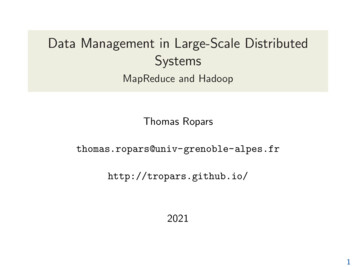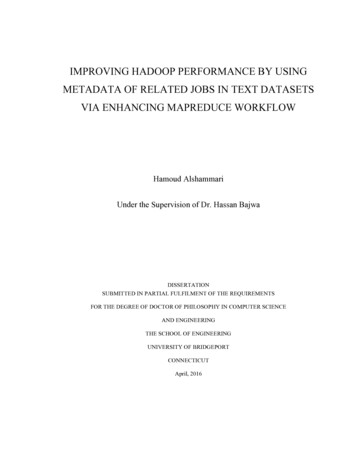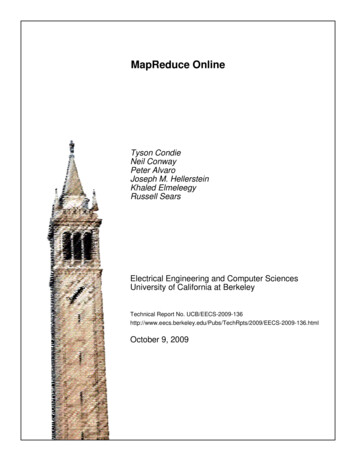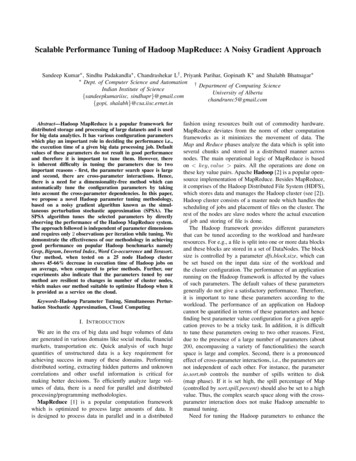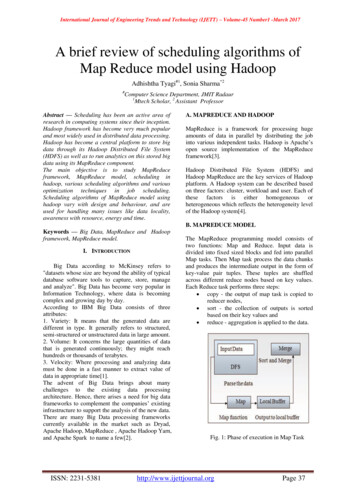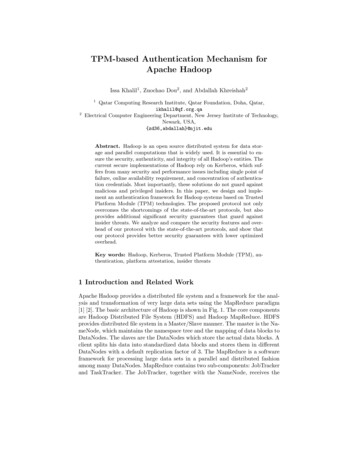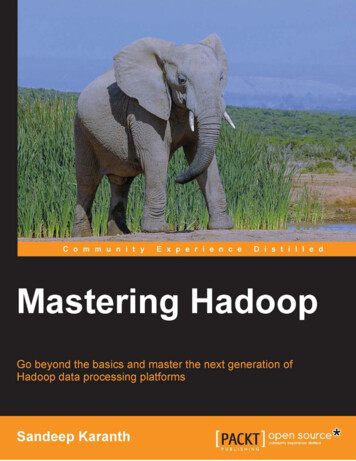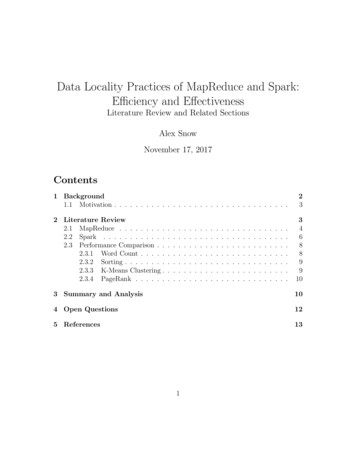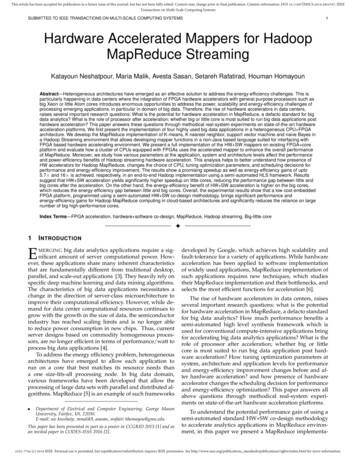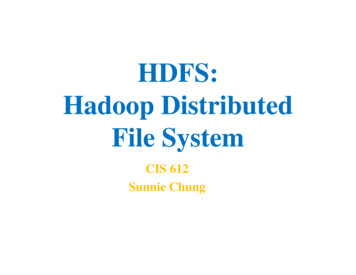
Transcription
HOG: Distributed Hadoop MapReduce on the GridChen He, Derek Weitzel, David Swanson, Ying LuComputer Science and EngineeringUniversity of Nebraska – LincolnEmail: {che, dweitzel, dswanson, ylu}@cse.unl.eduAbstract—MapReduce is a powerful data processing platformfor commercial and academic applications. In this paper, webuild a novel Hadoop MapReduce framework executed on theOpen Science Grid which spans multiple institutions across theUnited States – Hadoop On the Grid (HOG). It is differentfrom previous MapReduce platforms that run on dedicatedenvironments like clusters or clouds. HOG provides a free, elastic,and dynamic MapReduce environment on the opportunisticresources of the grid. In HOG, we improve Hadoop’s faulttolerance for wide area data analysis by mapping data centersacross the U.S. to virtual racks and creating multi-institutionfailure domains. Our modifications to the Hadoop frameworkare transparent to existing Hadoop MapReduce applications. Inthe evaluation, we successfully extend HOG to 1100 nodes on thegrid. Additionally, we evaluate HOG with a simulated FacebookHadoop MapReduce workload. We conclude that HOG’s rapidscalability can provide comparable performance to a dedicatedHadoop cluster.I. I NTRODUCTIONMapReduce [1] is a framework pioneered by Google forprocessing large amounts of data in a distributed environment.Hadoop [2] is the open source implementation of the MapReduce framework. Due to the simplicity of its programmingmodel and the run-time tolerance for node failures, MapReduce is widely used by companies such as Facebook [3], theNew York Times [4], etc. Futhermore, scientists also employHadoop to acquire scalable and reliable analysis and storageservices. The University of Nebraska-Lincoln constructed a1.6PB Hadoop Distributed File System to store CompactMuon Solenoid data from the Large Hadron Collider [5],as well as data for the Open Science Grid (OSG) [6]. Inthe University of Maryland, researchers developed blastreducebased on Hadoop MapReduce to analyze DNA sequences [7].As Hadoop MapReduce became popular, the number and scaleof MapReduce programs became increasingly large.To utilize Hadoop MapReduce, users need a Hadoop platform which runs on a dedicated environment like a cluster orcloud. In this paper, we construct a novel Hadoop platform,Hadoop on the Grid (HOG), based on the OSG [6] whichcan provide scalable and free of charge services for users whoplan to use Hadoop MapReduce. It can be transplanted to otherlarge scale distributed grid systems with minor modifications.The OSG, which is the HOG’s physical environment, iscomposed of approximately 60,000 CPU cores and spans109 sites in the United States. In this nation-wide distributedsystem, node failure is a common occurrence [8]. Whenrunning on the OSG, users from institutions that do not ownresources run opportunistically and can be preempted at anytime. A preemption on the remote OSG site can be caused bythe processing job running over allocated time, or if the ownerof the machine has a need for the resources. Preemption isdetermined by the remote site’s policies which are outside thecontrol of the OSG user. Therefore, high node failure rate isthe largest barrier that HOG addresses.Hadoop’s fault tolerance focuses on two failure levels anduses replication to avoid data loss. The first level is the nodelevel which means a node failure should not affect the dataintegrity of the cluster. The second level is the rack level whichmeans the data is safe if a whole rack of nodes fail. In HOG,we introduce another level which is the site failure level. SinceHOG runs on multiple sites within the OSG. It is possible thata whole site could fail. HOG’s data placement and replicationpolicy takes the site failure into account when it places datablocks. The extension to a third failure level will also bringdata locality benefits which we will explain in Section III.The rest of this paper is organized as follows. SectionII gives the background information about Hadoop and theOSG. We describe the architecture of HOG in section III. Insection IV, we show our evaluation of HOG with a well-knownworkload. Section V briefly describes related work, and VIdiscusses possible future research. Finally, we summarize ourconclusions in Section VII.II. BACKGROUNDA. HadoopA Hadoop cluster is composed of two parts: Hadoop Distributed File System and MapReduce.A Hadoop cluster uses Hadoop Distributed File System(HDFS) [9] to manage its data. HDFS provides storage forthe MapReduce job’s input and output data. It is designedas a highly fault-tolerant, high throughput, and high capacitydistributed file system. It is suitable for storing terabytes orpetabytes of data on clusters and has flexible hardware requirements, which are typically comprised of commodity hardwarelike personal computers. The significant differences betweenHDFS and other distributed file systems are: HDFS’s writeonce-read-many and streaming access models that make HDFSefficient in distributing and processing data, reliably storinglarge amounts of data, and robustly incorporating heterogeneous hardware and operating system environments. It divideseach file into small fixed-size blocks (e.g., 64 MB) and storesmultiple (default is three) copies of each block on cluster nodedisks. The distribution of data blocks increases throughput andfault tolerance. HDFS follows the master/slave architecture.
Fig. 1.HDFS Structure. Source: http://hadoop.apache.orgThe master node is called the Namenode which manages thefile system namespace and regulates client accesses to the data.There are a number of worker nodes, called Datanodes, whichstore actual data in units of blocks. The Namenode maintainsa mapping table which maps data blocks to Datanodes inorder to process write and read requests from HDFS clients.It is also in charge of file system namespace operationssuch as closing, renaming, and opening files and directories.HDFS allows a secondary Namenode to periodically save acopy of the metadata stored on the Namenode in case ofNamenode failure. The Datanode stores the data blocks inits local disk and executes instructions like data replacement,creation, deletion, and replication from the Namenode. Figure1 (adopted from Apache Hadoop Project [10]) illustrates theHDFS architecture.A Datanode periodically reports its status through a heartbeat message and asks the Namenode for instructions. EveryDatanode listens to the network so that other Datanodes andusers can request read and write operations. The heartbeatcan also help the Namenode to detect connectivity with itsDatanode. If the Namenode does not receive a heartbeat froma Datanode in the configured period of time, it marks the nodedown. Data blocks stored on this node will be considered lostand the Namenode will automatically replicate those blocksof this lost node onto some other datanodes.Hadoop MapReduce is the computation framework builtupon HDFS. There are two versions of Hadoop MapReduce:MapReduce 1.0 and MapReduce 2.0 (Yarn [11]). In this paper,we only introduce MapReduce 1.0 which is comprised of twostages: map and reduce. These two stages take a set of inputkey/value pairs and produce a set of output key/value pairs.When a MapReduce job is submitted to the cluster, it is dividedinto M map tasks and R reduce tasks, where each map taskwill process one block (e.g., 64 MB) of input data.A Hadoop cluster uses slave (worker) nodes to execute mapand reduce tasks. There are limitations on the number of mapand reduce tasks that a worker node can accept and executesimultaneously. That is, each worker node has a fixed numberof map slots and reduce slots. Periodically, a worker nodesends a heartbeat signal to the master node. Upon receiving aheartbeat from a worker node that has empty map/reduce slots,the master node invokes the MapReduce scheduler to assigntasks to the worker node. A worker node who is assigned amap task reads the content of the corresponding input datablock from HDFS, possibly from a remote worker node. Theworker node parses input key/value pairs out of the block,and passes each pair to the user-defined map function. Themap function generates intermediate key/value pairs, whichare buffered in memory, and periodically written to the localdisk and divided into R regions by the partitioning function.The locations of these intermediate data are passed back tothe master node, which is responsible for forwarding theselocations to reduce tasks.A reduce task uses remote procedure calls to read theintermediate data generated by the M map tasks of the job.Each reduce task is responsible for a region (partition) ofintermediate data with certain keys. Thus, it has to retrieveits partition of data from all worker nodes that have executedthe M map tasks. This process is called shuffle, which involvesmany-to-many communications among worker nodes. Thereduce task then reads in the intermediate data and invokes thereduce function to produce the final output data (i.e., outputkey/value pairs) for its reduce partition.B. Open Science GridThe OSG [6] is a national organization that provides services and software to form a distributed network of clusters.OSG is composed of 100 sites primarily in the United States.Figure 2 shows the OSG sites across the United States.Each OSG user has a personal certificate that is trusted bya Virtual Organization (VO) [12]. A VO is a set of individualsand/or institutions that perform computational research andshare resources. A User receives a X.509 user certificate [13]which is used to authenticate with remote resources from theVO.Users submit jobs to remote gatekeepers. OSG gatekeepersare a combination of different software based on the GlobusToolkit [14], [15]. Users can use different tools that cancommunicate using the Globus resource specification language[16]. The common tool is Condor [17]. Once Jobs arrive atthe gatekeeper, the gatekeeper will submit them to the remotebatch scheduler belonging to the sites. The remote batchscheduler will launch those jobs according to its schedulingpolicy.Sites can provide storage resources accessible with theuser’s certificate. All storage resources are again accessed by aset of common protocols, Storage Resource Manager (SRM)[18] and Globus GridFTP [19]. SRM provides an interfacefor metadata operations and refers transfer requests to a setof load balanced GridFTP servers. The underlying storagetechnologies at the sites are transparent to users. The storageis optimized for high bandwidth transfers between sites, andhigh throughput data distribution inside the local site.
Fig. 2.OSG sites across the United States. Source: http://display.grid.iu.edu/III. A RCHITECTUREThe architecture of HOG is comprised of three components.The first is the grid submission and execution component. Inthis part, the Hadoop worker nodes requests are sent out to thegrid and their execution is managed. The second major component is the Hadoop distributed file system (HDFS) that runsacross the grid. And the third component is the MapReduceframework that executes the MapReduce applications acrossthe grid.A. Grid Submission and ExecutionGrid submission and execution is managed by Condorand GlideinWMS, which are generic frameworks designedfor resource allocation and management. Condor is used tomanage the submission and execution of the Hadoop workernodes. GlideinWMS is used to allocate nodes on remote sitestransparently to the user.When the HOG starts, a user can request Hadoop workernodes to run on the grid. The number of nodes can grow andshrink elastically by submitting and removing the worker nodejobs. The Hadoop worker node includes both the datanode andthe tasktracker processes. The Condor submission file is shownin Listing 1. The submission file specifies attributes of the jobsthat will run the Hadoop worker nodes.The requirements line enforces a policy that theHadoop worker nodes should only run at these sites. Werestricted our experiments only to these sites because theyprovide publicly reachable IP addresses on the worker nodes.Hadoop worker nodes must be able to communicate to eachother directly for data transferring and messaging. Thus,we restricted execution to 5 sites. FNAL FERMIGRID andUSCMS-FNAL-WC1 are clusters at Fermi National Accelerator Laboratory. UCSDT2 is the US CMS Tier 2 hosted atthe University of California – San Diego. AGLT2 is the USAtlas Great Lakes Tier 2 hosted at the University of Michigan.Listing 1. Condor Submission file for HOGuniverse vanillarequirements GLIDEIN ResourceName ? "FNAL FERMIGRID" GLIDEIN ResourceName ? "USCMS-FNAL-WC1" GLIDEIN ResourceName ? "UCSDT2" GLIDEIN ResourceName ? "AGLT2" GLIDEIN ResourceName ? "MIT CMS"executable wrapper.shoutput condor out/out. (CLUSTER). (PROCESS)error condor out/err. (CLUSTER). (PROCESS)log hadoop-grid.logshould transfer files YESwhen to transfer output ON EXIT OR EVICTOnExitRemove FALSEPeriodicHold falsex509userproxy /tmp/x509up u1384queue 1000MIT CMS is the US CMS Tier 2 hosted at the MassachusettsInstitute of Technology.The executable specified in the condor submit file isa simple shell wrapper script that will initialize the Hadoopworker node environment. The wrapper script follows thesesteps in order to start the Hadoop worker node:1) Initialize the OSG operating environment2) Download the Hadoop worker node executables3) Extract the worker node executables and set late bindingconfigurations4) Start the Hadoop daemons5) When the daemons shut down, clean up the workingdirectory.Initializing the OSG operating environment sets the requiredenvironment variables for proper operation on an OSG workernode. For example, it can set the binary search path to includegrid file transfer tools that may be installed in non-standardlocations.
Fig. 3.HOG ArchitectureIn the evaluation the Hadoop executables package wascompressed to 75MB, which is small enough to transferto worker nodes. This package includes the configurationfile, the deployment scripts, and the Hadoop jars. It can bedownloaded from a central repository hosted on a web server.Decompression of the package takes a trivial amount of timeon the worker nodes, and is not considered in the evaluation.The wrapper must set configuration options for the Hadoopworker nodes at runtime since the environment is not knownuntil it reaches the node where it will be executing. TheHadoop configuration must be dynamically changed to pointthe value of mapred.local.dir to a worker node localdirectory. If the Hadoop working directory is on shared storage, such as a network file system, it will slow computationdue to file access time and we will lose data locality on theworker nodes. We avoid using shared storage by utilizingGlideinWMS’s mechanisms for starting a job in a workernode’s local directory.B. Hadoop On The GridThe Hadoop instance that is running on the grid has twomajor components, Hadoop Distributed File System (HDFS)and MapReduce, shown in Figure 3. The master servers,Namenode for HDFS and JobTracker for MapReduce, aresingle points of failure for the HOG system, therefore theyreside on a stable central server. If the master server becomesunavailable, execution of MapReduce jobs will stop and theHDFS file system will become unavailable (though no datawill be lost). When the grid jobs start, the slave servers willreport to the single master server.Hadoop requires worker nodes to be reachable by eachother. Some clusters in the Open Science Grid are designed tobe behind one or more machines that provide Network AddressTranslation (NAT) access to the Internet. Hadoop is unable totalk to nodes behind a remote NAT because NAT blocks directaccess. Therefore, we are limited to sites in the OSG that havea public IPs on their worker nodes.Failures on the grid are very common due to the site unavailability and preemption. It is important that HOG respondsquickly to recover lost nodes by redistributing data and processing to remaining nodes, and requesting more nodes fromthe grid. The Hadoop master node receives heartbeat messagesfrom the worker nodes periodically reporting their health. InHOG, we decreased the time between heartbeat messagesand decreased the timeout time for the worker nodes. If theworker nodes do not report every 30 seconds, then the nodeis marked dead for both the namenode and jobtracker. Thetraditional value for the heartbeat.recheck.intervalis 15 minutes for a node before declaring the node dead.1) HDFS On The Grid: Creating and maintaining a distributed filesystem on a disparate set of resources can bechallenging. Hadoop is suited for this challenge as it isdesigned for frequent failures.In traditional Hadoop, the datanode will contact thenamenode and report its status including information on thesize of the disk on the remote node and how much is availablefor Hadoop to store. The namenode will determine what datafiles should be stored on the node by the location of the nodeusing rack awareness and by the percent of the space that isused by Hadoop.Rack awareness provides both load balancing and improvedfault tolerance for the file system. Rack awareness is designedto separate nodes into physical failure domains and to loadbalance. It assumes that bandwidth inside a rack is much largerthan the bandwidth between racks, therefore the namenodewill use the rack awareness to place data closer to the source.For fault tolerance, the namenode uses rack awareness toput data on the source rack and one other rack to guardagainst whole rack failure. An entire rack could fail if anetwork component fails, or if power is interrupted to therack power supply unit. However, rack awareness requiresknowledge of the physical layout of the cluster. On the grid,users are unlikely to have knowledge of the physical layoutof the cluster, therefore traditional rack awareness would beimpractical. Instead, rack awareness in HOG is extended tosite awareness. We differentiate nodes based on their sites.Sites are common failure domains, therefore fitting wellinto the existing rack awareness model. Sites in the OSGare usually one or a few clusters in the same administrativedomain. There can be many failures that can cause an entiresite to go down, such as a core network component failure, ora large power outage. These are the errors that rack awarenesswas designed to mitigate.Also, sites usually have very high bandwidth between theirworker nodes, and lower bandwidth to the outside world.This is synonymous with HDFS’s assumptions about the rack,that the bandwidth inside the rack is much larger than thebandwidth between racks.Sites are detected and separated by the reported hostnames of the worker nodes. Since the worker nodes needto be publicly addressable, they will likely have DNSnames. For example, the DNS names will be broken upinto workername.site.edu. The worker nodes will beseparated depending on the last two groups, the site.edu.All worker nodes with the same last two groups will bedetermined to be in the same site.The detection and separation is done by a site awareness script, defined in the Hadoop configuration as
topology.script.file.name. It is executed each timea new node is discovered by the namenode and the jobtracker.In addition to site-awareness, we increased the defaultreplication factor for all files in HDFS to 10 replicas from thetraditional replication factor for Hadoop of 3. Simultaneouspreemptions on a site is common in the OSG since higherpriority users may submit many jobs, preempting many of ourHDFS instances. In order to address simultaneous preemptions, both site awareness and increased replication are used.Also, increased replication will guard against preemptionsoccurring faster than the namenode can replicate missing datablocks. Too many replicas would impose extra replicationoverhead for the namenode. Too few would cause frequent datafailures in the dynamic HOG environment. 10 replicas was theexperimental number which worked for our evaluation.2) MapReduce On The Grid: The goal of our implementation is to provide a Hadoop platform comparable to that of adedicated cluster for users to run on the grid. They should nothave to change their MapReduce code in order to run on ouradaptation of Hadoop. Therefore, we made no API changes toMapReduce, only underlying changes in order to better fit thegrid usage model.When the grid job begins, it starts the tasktracker on theremote worker node. The tasktracker is in charge of managingthe execution of Map and Reduce tasks on the worker node.When it begins, it contacts the jobtracker on the central serverwhich marks the node available for processing.The tasktrackers report their status to the jobtracker andaccept task assignments from it. In the current version of HOG,we follow Apache Hadoop’s FIFO job scheduling policy withspeculative execution enabled. At any time, a task has at mosttwo copies of execution in the system.The communication between the tasktracker and the jobtracker is based on HTTP. In the HOG system, the HTTPrequests and responses are over the WAN which has highlatency and long transmission time compared with the LANof a cluster. Because of this increased communication latency,it is expected that the startup and data transfer initiations willbe increased.Just as site awareness affects data placement, it also affectsthe placement of Map jobs for processing. The default Hadoopscheduler will attempt to schedule Map tasks on nodes thathave the input data. If it is unable to find a data local node,it will attempt to schedule the Map task in the same site asthe input data. Again, Hadoop assumes the bandwidth insidea site is greater than the bandwidth between sites.IV. E VALUATIONA. Experimental SetupIn this section, we employ a workload from the Facebookproduction cluster to verify HOG performance and reliability.The Facebook workload is used to construct the performancebaseline between our HOG and the dedicated Hadoop cluster.We create a submission schedule that is similar to the one usedby Zaharia et al. [3]. They generated a submission schedulefor 100 jobs by sampling job inter-arrival times and input sizesfrom the distribution seen at Facebook over a week in October2009. By sampling job inter-arrival times at random from theFacebook trace, they found that the distribution of inter-arrivaltimes was roughly exponential with a mean of 14 seconds.They also generated job input sizes based on the Facebookworkload, by looking at the distribution of number of maptasks per job at Facebook and creating datasets with the correctsizes (because there is one map task per 64 MB input block).Job sizes were quantized into nine bins, listed in Table I, tomake it possible to compare jobs in the same bin within andacross experiments. Our submission schedule has similar jobsizes and job inter-arrival times. In particular, our job sizedistribution follows the first six bins of job sizes shown inTable I, which cover about 89% of the jobs at the Facebookproduction cluster. Because most jobs at Facebook are smalland our test cluster is limited in size, we exclude those jobswith more than 300 map tasks. Like the schedule in [3], [20],the distribution of inter-arrival times is exponential with amean of 14 seconds, making our total submission schedule21 minutes long.TABLE IFACEBOOK P RODUCTION W 1-500501-1500 1501%Jobsat Facebook39%16%14%9%6%6%4%4%3%#Mapsin Benchmark1210501002004008004800# of jobsin Benchmark381614866444However, the authors [3] only provide the number of maptasks required by each job. In this paper, we introduce reducetasks to the workload. They number in a non-decreasingpattern compared to job’s map tasks. They are listed in TableII.TABLE IIT RUNCATED WORKLOAD FOR THIS PAPERBin123456Map Tasks121050100200Reduce Tasks115102030In this paper, we define the term “equivalent performance”.Two systems have equivalent performance if they have thesame response time for a given workload. We will buildthe HOG system and a Hadoop cluster to achieve equivalentperformance. Because the size of a Hadoop cluster is fixed,we need to tune the number of nodes in the HOG system toachieve equivalent performance.In order to avoid the interference caused by growing andshrinking in HOG, we first configure a given number of
TABLE IIID EDICATED M AP R EDUCE C LUSTER C ONFIGURATIONNodesQuantityMaster node1Slave nodes-I20Slave nodes-II10Hardware and HadoopConfiguration2 single-core 2.2GHzOpteron-248 CPUs, 8GB RAM,1Gbps Ethernet2 dual-core2.2GHz Opteron-275 CPUs,4GB RAM, 1 Gbps Ethernet,4 map and 1 reduce slots per node2 single-core2.2GHz Optron-64 CPUs,4GB RAM, 1 Gbps Ethernet,2 map and 1 reduce slots per nodenodes that HOG will achieve and wait until HOG reaches thisnumber. Then, we start to upload input data and execute theevaluation workload.We first built a Hadoop cluster which contains 30 workernodes that are configured as one rack. The worker nodes-Igroup contains 20 nodes. Each of them has 2 dual-core CPUs.The worker nodes-II group contains 10 nodes, each with only2 single-core CPUs. The cluster is composed of 100 CPUs.Detailed hardware information is listed in the Table III. OurHadoop cluster is based on Hadoop 0.20. We used loadgen,which is a test example in Hadoop source code and used inevaluating Hadoop schedulers [3], [20] to get the performancebaseline. We configure 1 reduce slot for each worker nodebecause there is only one Ethernet card in each node and thereduce stage involves intensive network data transfer. Also,configure 1 map slot per core. Other configuration parametersfollow the default settings of Hadoop from Apache [9]. Forthe HOG configuration, we configure each node to have 1 mapslot and 1 reduce slot, since the job is allocated 1 core on theremote worker node.HOG vs. Cluster Equivalent Performance5000HOGCluster (100 cores)40Response Time (second)450040005535006050993000100171132nodes to achieve equivalent performance when compared toour 100-core Hadoop cluster.We performed 3 runs at each sampling point. The samplingpoint was set as the maximum number of nodes configuredto join HOG. We waited until the available nodes reachedthe maximum and started execution. During execution, nodesleft the system, and other nodes replaced them, but we onlymarked on the graph with the maximum nodes that could beavailable.We can also see from Figure 4 that the response time of theworkload does not always decrease with the increasing numberof nodes in the HOG system. There are many reasons. As iswell known, HOG is based on a dynamic environment and theworker nodes are opportunistic. Once some nodes leave, theHOG system will automatically request more nodes from theOSG to compensate for the missing worker nodes. However,it takes time for requesting, configuring, and starting a newworker node. At the same time, the newly added nodes haveno data. HOG has to either copy data to those nodes or starttasks without data locality. The more dynamic the resourceenvironment is, the longer the response time will be.In order to verify our analysis, we examine three executionsof the HOG system with 55 nodes. Figure 5 shows the numberof available nodes in the HOG system during the workloadexecution. We set the maximum number of nodes in HOGto 55, though the reported number of nodes in the figurefluctuated above 55 momentarily as nodes left but where notreported dead for their heartbeat timeout. Figure 5a and 5bshow smaller node change compared with Figure 5c. In TableIV, we can see Figure 5b shows the shortest response time andFigure 5c shows the longest response time. We also use thearea which is beneath the curve during the execution of theworkload, to demonstrate the node fluctuation. It also verifiedour analysis of the workload executions.We can avoid this fluctuation by running multiple copiesof MapReduce jobs in the HOG system. Currently, Hadooponly uses multiple executions for slower tasks (1/3 slower thanaverage) execution, and at most two copies for a task. In ourfuture work, we will make all tasks have configurable numberof copies running in the HOG and take the fastest as the result.In this way, the HOG can finish MapReduce jobs faster evenwhen there are some nodes missing.250011011602000180974150050100250500Number of Nodes in HOGFig. 4.1000LogrithmicHOG System PerformanceB. Equivalent PerformanceIn the Figure 4, the dashed line is the response time of theworkload in our local cluster and the solid line is the responsetime of the HOG cluster executing on the OSG. We can seethe solid line crosses the dashed line when the HOG has 99to 100 nodes. We see that the HOG system needs [99,100]C. ScalabilityAs we mentioned in our introduction, HOG is scalable. Ifusers want to increase the number of nodes in the HOG, theycan submit more Condor jobs for extra nodes. They can usethe HDFS balancer to balance the data distribution. In our experiments, we elastically extend our system from 132 to 1101nodes and run the workload to verify HOG’s performance.Figure 4 shows the response time of the workload in differentnumber of nodes in HOG. In general, we can obtain shorterresponse time if there are more nodes in the HOG system.However, there are downsides if we keep increasing the sizeof HOG. First of all, the data movement and replication cannotbe neglected because this process will impose extra overhead
(a) 55 stable nodes(b) 55 stable nodesFig. 5.TABLE IVA REA BENEATH CURVESFigure No.5a5b5cResponse Time439638966235(c) 55 unstable nodesHOG Node FluctuationArea181020172360252455on the Namenode and Datanode. The performance of HOGwill degrade if replication happens during the execution of aworkload.Secondly, the probability of losing a node rises with theincreasing of cores in HOG. As we can see in the Table IV,the more node fluctuation, the longer response we will getfor a given workload. The performance may degrade as nodefailure increases.D. ExperiencesWe learned so
A Hadoop cluster is composed of two parts: Hadoop Dis-tributed File System and MapReduce. A Hadoop cluster uses Hadoop Distributed File System (HDFS) [9] to manage its data. HDFS provides storage for the MapReduce job's input and output data. It is designed as a highly fault-tolerant, high throughput, and high capacity distributed file system.
